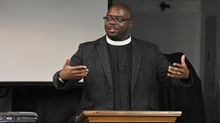"Jesus Saves": More than words

Jesus Saves: More Than Words
The United States is not a Christian nation. It is a nation with Christians. Expressing the Christian faith has been problematic in our history. This history includes both the affirmation and abolition of slavery. It includes the freedom of conscience and manifest destiny. It includes peaceful marches and non-disclosure agreements. And now, as of January 6, 2021, it includes signs at the political rally leading to the riot storming the Capitol building that read “Jesus Saves.”[1]
The truth that “Jesus Saves” is foundational to all Christians. Without Jesus we have no hope. As Christians, we recognize that the mess of the world is not something we can undo ourselves; only God can do that. Only Jesus, the divine-human mediator sent by God and guided by the Spirit, undoes our mess.
Jesus shows us what loyalty to God above any earthly thing looks like. It looks like a willingness to be born into a world of sin and death; it looks like the Beatitudes on a hill; it looks like a firm resolution to live faithfully for God even when faithfulness leads directly to a cross at the hands of political and religious powers. It looks like a resurrection that promises hope for all who see and hear and follow faithfully after him.
So, what does it mean when “Jesus Saves” is invoked at a rally attempting to exert political power? Language is never divorced from context. Were these signs meant as a rebuke to those present- a declaration that political power does not save? Or were they intended as an invocation of divine support for attempted political domination?
The words, the person saying them, and the cultural context all interact to create meaning. The inability or unwillingness of American Christians to see the meaning created by words used in a particular context leaves us vulnerable to manipulation and misappropriation. Anglican priest Tish Harrison Warren describes this lack of discernment and calls particular evangelical leaders and the white American church to account for their enablement in the conflation of faith and worldly power.[2] Like Paul, she sees the corruption of false teaching and its corrosive effects.
In 1 & 2 Timothy, Paul lines out a path forward for his successor to follow (1 Tim 1:2; 2 Tim 1:2). Paul is concerned with false doctrine, truth and passing down right teaching (1 Tim 1:3-7; 2 Tim 3:1-9, 13-17). He anticipates the conclusion of his ministry and his absence (2 Tim 4:6-7). Paul sends letters as a substitute for his presence.[3] He knew his letters would be read repeatedly in worship services and he clarifies his apostolic role lending them Scripture-like authority.[4] In Thessalonians, Paul commends the church for realizing that the word of God came through Paul’s teaching; it wasn’t merely human wisdom (1 Thess 2:13).
Paul may not have directly equated his letters with the Jewish Scriptures (what we associate with the Old Testament), but he was aware of their value and the importance of passing on his message (2 Tim 4:1-5). Connecting Paul’s in-person preaching and his letters as two different expressions of his presence helps us see that the churches would also accept his letters as the word of God.[5]
Paul’s method of spiritual development through presence will aid Timothy when he is gone. The heart of Paul’s instruction is always Jesus as God’s redemption for the world. From this truth flows spiritual renewal for individuals and communities.[6] The way renewed people live is sensitive to culture, always wanting others to see a reflection of Christ.[7]
Paul gives instructions to specific groups encouraging them to live in a way that is not shameful to those outside the faith and demonstrates the attractiveness of the gospel.[8] Paul adapts what it looks like to faithfully follow Jesus in their world and trusts the Lord to bring Timothy further understanding (2 Tim 2:7).
The gospel that Paul preaches comes through the calling of God and the Spirit’s inspiration of scripture (2 Tim 1:11, 3:16). It is taught and modeled from one person to the next through individuals and communities.
It brings renewal that Christians are meant to share with the world through their lifestyle, character, and testimony. Paul gives us discernment for expressing the Christian faith today as we proclaim, “Jesus Saves.”
[1] Tom Gjelten, “Faith Leaders Nearly Unanimous In Condemning Assult on Capitol,” NPR, January 7, 2021, https://www.npr.org/2021/01/07/954581163/faith-leaders-nearly-unanimous-in-condemning-assault-on-capitol.
[2] Tish Harrison Warren, “We Worship with the Magi, Not MAGA,” Christianity Today, January 7, 2021, https://www.npr.org/2021/01/07/954581163/faith-leaders-nearly-unanimous-in-condemning-assault-on-capitol.
[3] Sidney Greidanus, “Preaching from Paul Today," in Dictionary of Paul and His Letters, ed. Gerald F. Hawthorne, Ralph P. Martin, and Daniel G. Reid (Downers Grove, Ill: InterVarsity Press, 1993), 738.
[4] Grant Osborne, "Hermeneutics/Interpreting Paul," in Dictionary of Paul and His Letters, ed. Gerald F. Hawthorne, Ralph P. Martin, and Daniel G. Reid (Downers Grove, Ill: InterVarsity Press, 1993), 391.
[5] Greidanus, Preaching from Paul Today, 738.
[6] Ibid., 743.
[7] Osborne, Hermeneutics/Interpreting Paul, 396.
[8] Bruce W. Longenecker and Todd D. Still, Thinking through Paul: An Introduction to His Life, Letters, and Theology (Grand Rapids, MI: Zondervan, 2014), 270.
Jesus Creed is a part of CT's
Blog Forum. Support the work of CT.
Subscribe and get one year free.
The views of the blogger do not necessarily reflect those of Christianity Today.




















